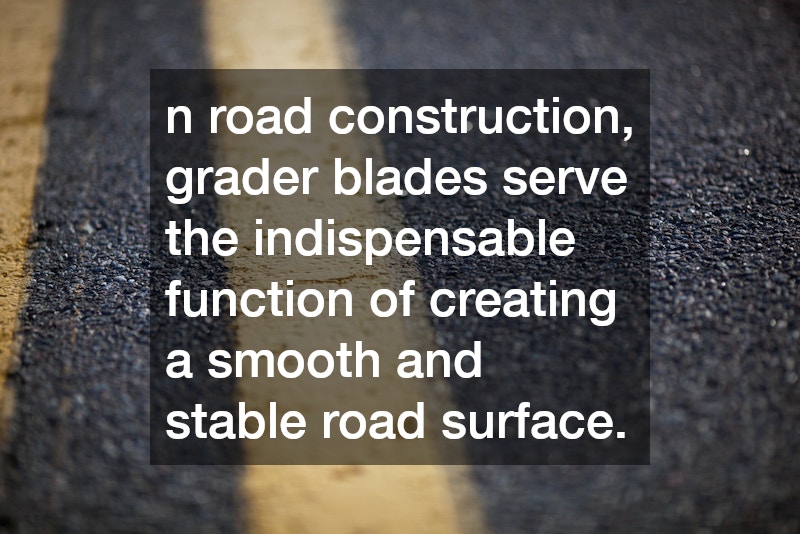
Grader blades are an essential component in the construction and maintenance of roads. These blades are typically attached to a motor grader, a versatile piece of heavy machinery used to create smooth, flat surfaces. A grader blade’s primary function is to level and grade the surface, ensuring it is even and complies with specified design features. The durability and effectiveness of a grader blade are primarily determined by its material and construction, requiring meticulous selection for optimal performance. As each application may require different specifications, the significance of choosing the right grader blade cannot be overstated.
Importantly, the grader blade barstock is a critical aspect in determining the overall robustness and longevity of the blade. This barstock is the raw material from which the blade is manufactured, typically comprising high-grade steel known for its strength and durability. The choice of barstock can significantly influence the grader blade’s wear resistance and operational lifespan, directly affecting the efficiency of the machinery. Moreover, technological advancements have led to the development of specialized barstock materials that enhance the performance characteristics of grader blades. This selection of barstock is an important factor for businesses aiming to reduce maintenance costs and downtime.
Understanding the critical role of grader blade barstock provides insight into the broader domain of earthmoving equipment. As vital components of road construction, grader blades contribute to enhanced productivity and output quality. The relationship between the grader blade’s material properties and its performance is critical for operators and equipment managers. Inadequate barstock can lead to increased wear and operational failure, which interrupts projects and resources. Thus, investing in high-quality grader blade barstock is an essential consideration for any construction or maintenance operation utilizing graders.
The Role of Grader Blades in Road Construction
In road construction, grader blades serve the indispensable function of creating a smooth and stable road surface. They are responsible for the cutting, spreading, and leveling of materials like soil, gravel, and asphalt. These operations must be performed with precision to guarantee the safety and performance of the road. The efficiency of a grader blade directly affects the quality of the road construction output, influencing everything from drainage to pavement longevity. Therefore, superior grader blade design and manufacturing are prerequisites for reliable road infrastructure.
Reliability and consistency are of paramount importance in heavy-duty operations, necessitating advanced grader blade designs. Blades must withstand considerable wear and mechanical stress to perform long-term successfully. Consequently, choosing the right grader blade barstock for these applications becomes crucial. Varied construction environments present differing challenges that demand specific blade characteristics, making selection based on performance requirements essential. The need for abrasion resistance and strength is met by utilizing specialized materials like high-carbon steel in the manufacturing process.
High-quality grader blades not only improve the immediate outputs of construction projects but also have long-term economic benefits. Investing in superior blades reduces the frequency of replacements and repairs, thereby cutting operational costs. When grader blades are crafted from resilient materials, they endure more substantial workloads and extend the period between maintenance shut-downs. This durability is a significant advantage for companies focused on cost-effective, sustainable road construction solutions. Enhanced grading capacity using effective blade barstock translates to increased project efficiency and profitability.
Choosing the Right Grader Blade Material
The selection of grader blade material is central to optimizing performance and extending the equipment’s life cycle. Traditionally, high-carbon and boron steels have been favored for their resilience under extensive workloads. Such materials offer excellent abrasion resistance, a critical factor when the blade is exposed to various terrains and operational conditions. A grader blade’s structural integrity, therefore, directly correlates to its composition—making material selection crucial for effective grading outcomes. The characteristics of the base material help determine the operational parameters, directly impacting the grader’s effectiveness in real-world scenarios.
Advanced manufacturing techniques in grader blade production now incorporate alloyed materials to improve specific blade features. These techniques blends various metals to achieve superior hardness, flexibility, and durability. The infusion of alloying elements enhances the blade’s resistance to wear and tear, increasing its operating lifespan and efficiency. Furthermore, careful selection of these materials and production processes minimizes maintenance intervals and prolongs grader life cycles. Hence, meticulous attention to material properties can yield substantial productivity gains in grader blade applications.
Decisions regarding grader blade composition are grounded in the identification of application-specific needs. Specialized grader blades are designed to meet the unique challenges posed by diverse worksite environments. For instance, blades intended for gravel roads require certain hardness and wear resistance that may differ from those used in snow removal. By aligning the grader blade material with operational demands, construction companies ensure optimal performance across various tasks. Investing in grade-specific blades facilitates better construction outcomes and maximizes utility, promoting wise resource management.
Maintenance and Longevity of Grader Blades
Regular maintenance is vital to prolong the service life of grader blades and ensure peak performance. Routine inspections help detect wear and tear early, allowing for timely intervention and replacement if necessary. Checks should focus on common problem areas such as chipping, bending, or excessive wear, which can jeopardize grading operations. Regular sharpening and adjustment further enhance the functional life of the grader blade. Through diligent maintenance practices, operators can optimize blade efficiency and machinery uptime.
The composition of a grader blade plays a significant role in determining maintenance needs. Blades crafted from durable materials require less frequent servicing and exhibit less wear over time, making material choice critical. Using high-grade barstock in blade manufacturing lessens the severity and frequency of repairs, effectively lowering operating costs. Additionally, advanced blade designs offer self-sharpening features, further reducing maintenance routines. Proactive efforts in maintaining blade integrity translate into extended usage periods and reliability.
Ensuring grader blade longevity also involves proper storage and handling techniques. Protecting blades from extreme environmental conditions prevents material degradation over time. Implementing secure and stable storage solutions helps prevent damage and maintains blade readiness for deployment. Additionally, training operators on best handling practices reduces the likelihood of inadvertent damage during use or transport. Cultivating a culture of blade preservation within construction operations facilitates sustained equipment performance and optimizes resource utilization.
Grader blades are fundamental components in construction projects, playing a crucial role in achieving high-quality road surfaces. By understanding the impact of grader blade barstock and other material factors, operators can make informed decisions in selecting the most effective blades for their specific needs. Prioritizing the use of high-quality materials and consistent maintenance practices guarantees maximum efficiency and a longer-lasting product. Designing blades with advanced materials tailored to specific tasks ensures better performance across varied construction environments. With the right grader blades, road construction and maintenance endeavors are poised for improved productivity and success.
In conclusion, whether dealing with gravel, soil, or snow, investing in the right grader blade material is paramount for efficient operational outcomes. By aligning blade composition with task demands and maintaining diligent care, businesses can achieve optimal blade performance and extend life cycles. Reflecting the versatility of grader blades, a strategic approach to their selection and maintenance promotes successful, cost-effective construction operations. Grader blades remain indispensable to the efficacy of road construction equipment, underscoring their role in infrastructure projects. Encouraging informed decisions and steady upkeep, grader blades are invaluable tools in modern construction and maintenance practices.




